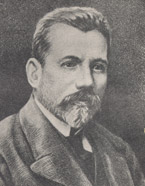The directory «Plots»
Stefanyk (Ñòåôàíèê) Vasyl Semenovich
(1871—1936)

Ukranian writer, he was master of impressionist prose. In the course of his studies Stefanyk became aquainted with Les Martovych and Lev Bachynsky, both of whom had an influence on his life: Martovych turned him to writing, and Bachynsky steered him toward community-political involvement. Later, while he was a student of medicine at Cracow University, Stefanyk was befriended by the Polish doctor Wacław Moraczewski and his wife, Sofiia Okunevska-Moraczewska, who aquainted him with contemporary European culture and literature and with the members of the then-fashionable Polish avant-garde group Młoda Polska, particularly with Stanisław Przybyszewski, Władysław Orkan and Stanisław Wyspianski. The hectic and interesting Bohemian life is reflected in Stefanyk's letters, in which references to the works of modernist authors, such as Charles Baudelaire, Gottfried Keller, Paul Verlaine, Maurice Maeterlinck, and Paul Bourget, abound. Stefanyk's letters, full of poetic prose, lyricism, and introspection, also provide glimpses of the future master of the short story in the various narrative vignettes. Attempts to publish some of the introspective poetic prose in newspapers were unsuccessful, but in 1897 the terse narratives of scenes observed by Stefanyk appeared in «Pratsia»; they were followed by several novellas in «Literaturno-naukovyi vistnyk» (1898) and finally by Stefanyk's first collection of novellas, «The Blue Book» (1899). With its appearance came immediate literary acclaim, and other collections followed: «The Stone Cross» (1900), «The Road» (1901), and «My Word» (1905).
In 1901 Stefanyk was at the height of his literary career, but for the next 15 years he wrote nothing. From 1908 until the collapse of the Austro-Hungarian Empire Stefanyk was a member of the Austrian parliament, elected as a substitute for Volodmyr Okhrymovych in 1907 from the Ukrainian Radical party in Galicia. The horror of the First World War jolted him back into writing in 1916, and he produced one more collection, «Earth» (1926). During the period of the Western Ukrainian National Republic, as a former member of parliament, Stefanyk became vice-president of the Ukrainian National Rada, and in 1919 he went to Kyiv for the signing of the agreement with the Ukrainian National Republic on the unification of Ukraine. In 1922 he became a district head of the Radical party. Recognizing him as the greatest living writer in Western Ukraine, the government of Soviet Ukraine decreed a life pension for Stefanyk, which he turned down in protest against the repressions in Ukraine. In addition to his five collections of novellas, Stefanyk published stories, in several editions of collected works: an edition in 1927 in Soviet Ukraine; a jubilee edition (Lviv 1933); an émigré edition edited by his son, Yurii Stefanyk (Regensburg 1948); and the three-volume ‘academic’ edition, published in Ukraine (1949–1954). A 1964 edition of Stefanyk's selected works, edited by Vasyl Lesyn and Fedir Pohrebennyk, complemented and corrected some of the lacunae and faults of the ‘academic’ edition.
Stefanyk's whole literary output consisted of 59 published novellas, most of them no longer than a couple of pages. In them he showed himself a master of a species of the short story genre, the Stefanyk novella, which is characterized by a succinct and highly dramatic form used to capture single crucial moments in the life of a hero. The dramatic quality of the novellas ensured their being successfully staged as plays by Volodymyr Blavatsky and adapted for film («The Stone Cross», screenplay by Ivan Drach). The heroes of Stefanyk's stories are for the most part peasants from his native Pokutia. Against the general background of poverty or war (in the later stories) Stefanyk showed his heroes in a universal dilemma, confronting the pain at the heart of existence. Stefanyk concentrated on capturing the turbulence of the soul, the inner agon, which revealed the psychological complexity of the hero. His characterizations were achieved through the speech of the characters. Words spoken became important not only for their meaning but also for the elements of skaz, which throw direct light on the character's emotional state, personality, social position, and degree of literacy. The special blend of literary Ukrainian and the Pokutia dialect created a flavor not easily duplicated or translated. Nevertheless there have been several attempts to translate Stefanyk into Polish, German, and Russian. The French translation La croix de pierre et autres nouvelles appeared in 1975, and the following English translations have appeared: The Stone Cross (1971), Maple Leaves and Other Stories (1988), and some individual stories in anthologies.
Ukraine, 1996, Vasil Stefanik
Ukraine, 1996.05.16,  Rusiv. Vasil Stefanik
Rusiv. Vasil Stefanik
USSR, 1971.05.14,  Ivano-Frankovsk. Vasyl Stefanyk
Ivano-Frankovsk. Vasyl Stefanyk
USSR, 1971.05.14,  Kiev. Vasyl Stefanyk
Kiev. Vasyl Stefanyk
USSR, 1971,  Vasyl Stefanyk
Vasyl Stefanyk